Table of Contents
Of the 220 million tons of refuse collected annually in the United States, it is estimated that about 30 million tons are incinerated, generating about 7 million tons of residues. In previous work, the Bureau of Mines developed a continuous mechanical process capable of converting 85 percent of municipal incinerator residues into potentially useful products. That process is presently being scaled up in a demonstration-size plant with a capacity of 250 tons of residues per day at Lowell, Mass.
The huge tonnage of refuse that is not incinerated is generally disposed of by sanitary landfill or open dumping. The potential value of materials contained in this portion is far greater than that of the materials contained in incinerator residues. Conceivably, the products that could be reclaimed might also be of higher quality. In addition, processing of the combustible portion could yield plastic and paper fractions that might be used to make new products. The combustibles, alternatively, could be utilized as a source of energy by burning to produce steam, by pyrolysis to produce combustible gases and oil, or by conversion to oil with carbon monoxide and steam.
Development of a successful raw refuse recovery process would not only provide a means for municipalities to generate revenue from the sale of products, but a major financial gain could be realized by savings in costs of haulage and landfill operations. Widespread adoption of the process by major municipalities and densely populated regions would also contribute significantly to conservation of our natural resources.
Thus, even before the incinerator residue recovery process had been fully optimized, the Bureau of Mines began research to develop a companion process to recover materials of major value from raw refuse. At the same time, other researchers were well advanced in developing processes for recycling some of the components of raw refuse. The approach taken by the Bureau was aimed at developing a complete system for separating the components of refuse into as many products as necessary to permit maximum recycling of all materials. Raw refuse was viewed as an ore just as was the case with incinerator residues. Therefore, mineral engineering analysis and mineral engineering principles were applied to separate the components of refuse into product concentrates which with a final cleaning could be converted into potentially useful materials. The present report describes the flowsheet and the pilot plant that resulted from these studies.
Technical Considerations
The first step necessary in mineral beneficiation of ores is size reduction to liberate the minerals that are to be recovered. A primary consideration is to avoid overgrinding so that the required separations can be made using the maximum practical size of material. It is also extremely important that product concentrates be recovered in the form most suitable for further processing and refinings. At the same time the concentrating plant must be assembled such that it can accept all types of materials likely to be present in the feed without fear of damage to equipment. In the case of low-grade ores, such as urban refuse, it is essential that all processing equipment have extremely high capacity and operate with minimum energy requirements.
In view of the above considerations, it appeared that in processing raw refuse the first step required would be coarse shredding in a low-horsepower machine to liberate materials contained in plastic and paper bags and boxes without damage to equipment from such items as massive metal objects that are frequently found in refuse. The coarseness of grind must be such that materials like paper, cardboard, and plastics are reduced to a size suitable for subsequent processing. In addition, tin cans must be discharged without balling and folding, and glass should be shattered with a minimum production of fines. Balled and folded cans would contain entrapped residual food and other trash, making them unsuitable for detinning. Lightly damaged cans, on the other hand, could be reshredded into potato-chip-shaped pieces which could easily be washed to remove food matter and labels. Balled and folded cans would also prevent access of caustic detinning solution to metal surfaces. A coarse glass product is desired for ease of recovery and to permit subsequent separation by color.
Finally, the process must be completely mechanized to avoid unnecessary exposure of plant operators to potential health hazards.
Flowsheet
Early in the research, preliminary tests were requested from manufacturers of the various kinds of commercially available equipment that might have application in the process to be developed. Based on the results of these tests, the flowsheet shown in figure 1 was designed. Equipment for the pilot plant was sized for a- processing capacity of 5 tons of refuse per hour.
Raw refuse from a typical collection route in metropolitan Washington D.C. is delivered to the pilot plant by packer truck, and the load is pushed through a door at the loading ramp onto the floor of the plant at the feed conveyor, as shown in figure 2. Refuse is raked onto the conveyor that feeds the primary shredder (A), which has a feed opening of 36 by 26 inches. This machine is a double-opposed flail mill that performs the coarse shredding and liberates materials to be reclaimed. The mill is adjusted so that glass is shattered without producing excessive amounts of fines, cans are only dented or sliced, and massive metal objects pass through the machine without causing damage. Each rotor is driven by a 40-hp motor. The speed of each can be varied independently up to 1,650 rpm; Figure 3 shows the mill, with the feed conveyor in the background.
A hood (B), also shown in figure 3, is positioned over the shredder discharge conveyor to control dusting and to suck up the very lightest pieces of shredded refuse from the top of the moving bed. Airflow rate at the hood is 2,700 cfm. Suction is created by a fan pulling through a cyclone (H), where the entrained refuse is collected. Most of the light-gage iron is then removed from the shredded refuse by a suspended-belt magnetic separator (C), figure 4. This device is adjusted to a height such that heaviest iron objects are not picked up. At the present time the magnet is positioned 10 inches
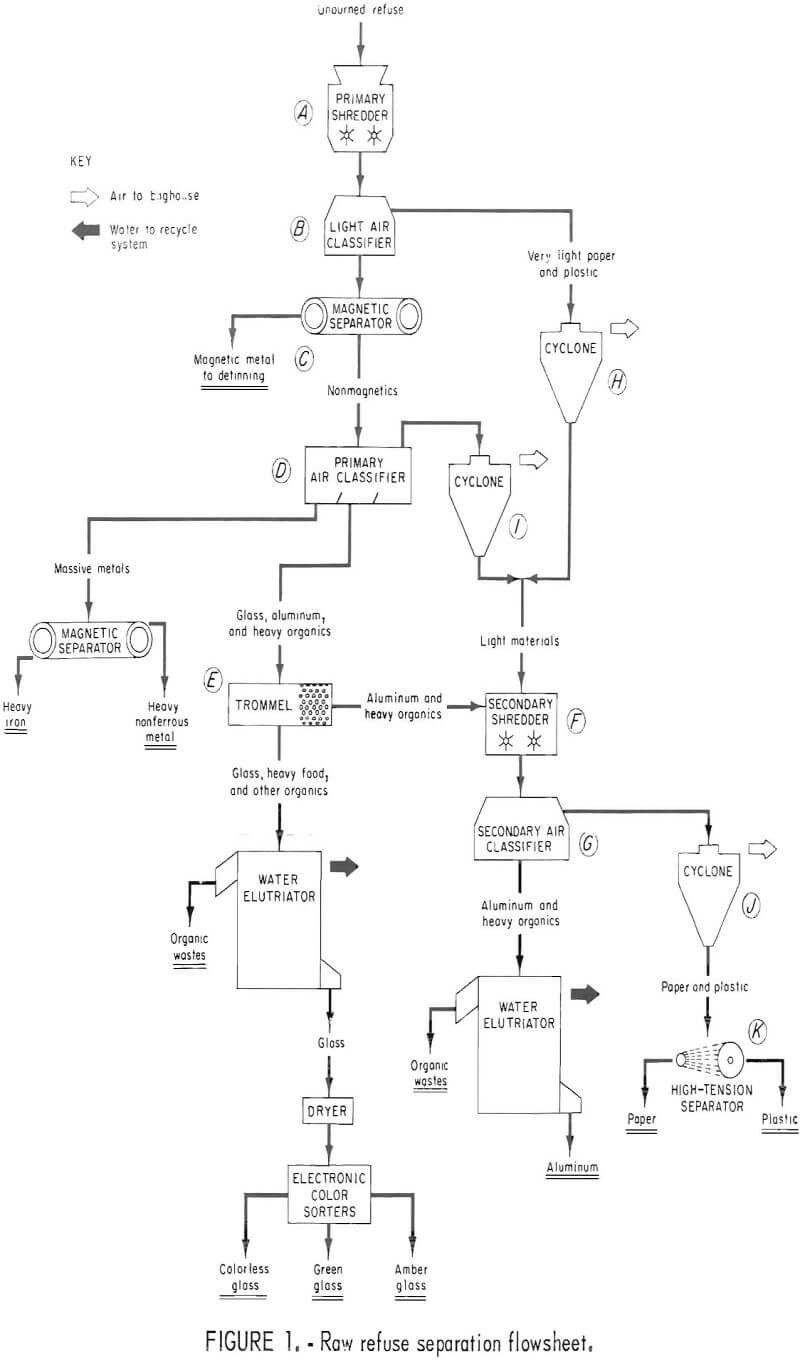
above the conveyor belt. The light-gage iron product that is separated is suitable at this point for final preparation prior to detinning.
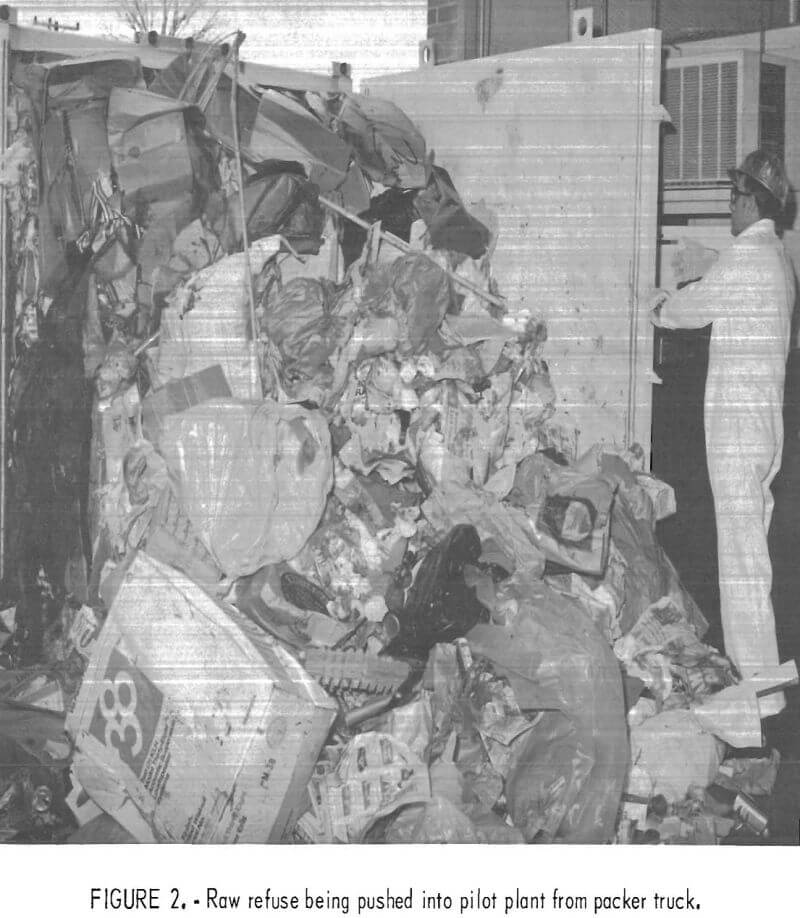
The remaining material is fed to a horizontal primary air classifier (D), figure 5. The design of this unit is based on a prototype that was built and operated successfully at the Bureau’s Salt Lake City Metallurgy Research Center. Refuse enters from an opening in the top at one end of the classifier (right-hand side of fig. 5) and falls into a stream of air blown horizontally into the side at the same end. Airflow rates can be varied from 1,000 to 5,000 cfm. At rates above 5,000 cfm, turbulence is created, reducing the efficiency of the unit. Very heavy objects fall vertically through the stream of air to a conveyor which carries them to a container. Other materials are blown past a divider (bottom right of fig. 5) where a stream of air rising from an opening in the bottom of the classifier entrains the light shredded material. This airstream is created by a suction fan at the end of the processing system. The air, with entrained light material, is pulled into a cyclone, figure 6, where the solids are collected. The fan then pulls the air through a dust collector, figure 7, before it is discharged to the atmosphere. Maximum airflow rate at the rectangular discharge of the classifier is 9,300 cfm. The cyclone product includes most of the paper in the incoming refuse, as well as light plastics and fabrics.
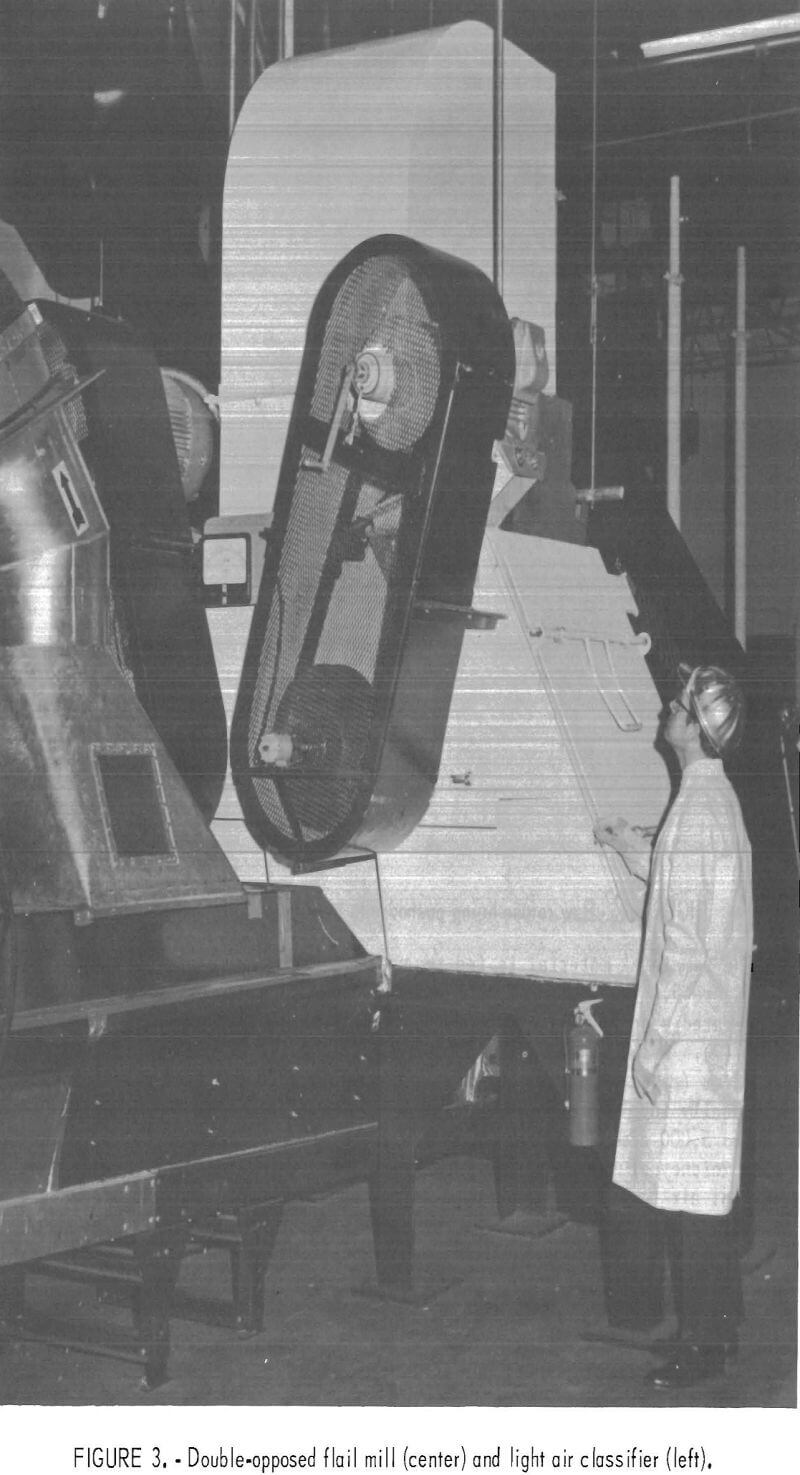

Materials blown past the divider, but not entrained with light shredded material, fall through the rising airstream to a conveyor. This product includes most of the glass, aluminum, food wastes, leather, heavy plastics, wood, rubber, and partially shredded magazines entering the air classifier. These materials are conveyed to a rotating trommel screen (E), figure 8, having 2-¼-inch holes. The trommel is 4 feet in diameter with a screen section 6 feet long and is rotated at 13 rpm. Glass, food wastes, and small amounts of other material pass through the 2-¼-inch holes to a conveyor to be carried to a container. Water elutriation of this product in the unit, shown in figure 9, produces a glass product and an organic waste containing dirt and fine glass. The water elutriator is a development of the Bureau’s Salt Lake City Metallurgy Research Center. The glass concentrate is dried and screened on a 4-mesh screen (not shown in fig. 1). Plus 4-mesh material is fed to electronic color sorters, figure 10, and separated into concentrates of colorless, green, and amber glass. Minus 4-mesh material is discarded.
The materials discharged out the end of the trommel are joined with light materials collected by the cyclones before moving to a secondary shredder (F), figure 11. The shredder is a cutter-type machine that chops the refuse into pieces from 1 to 3 inches in size. This machine is driven by a 75-hp motor and has a fixed speed of 5,560 rpm.

The shredded product discharges directly into a secondary air classifier (G), shown just below the shredder in figure 11. The device presently in use is a commercially available three-stage aspirator. Heavy material including aluminum, wood, heavy plastic, leather, and rubber falls through the open bottom into a collecting bin, and light material is pulled by a fan into a cyclone (J), where it is collected. Air from the cyclone passes through a dust collector before being discharged to the atmosphere. The average air velocity presently being used is 5,300 cfm. Water elutriation of the heavy product separates aluminum from combustibles.
The major part of the final shredded light materials is discharged from the cyclone (J) to a baler. The remainder is diverted to an electrostatic separator (K), figure 12, where paper and plastics are separated. This is a small laboratory device that is not capable of treating the entire paper and plastic output of the plant
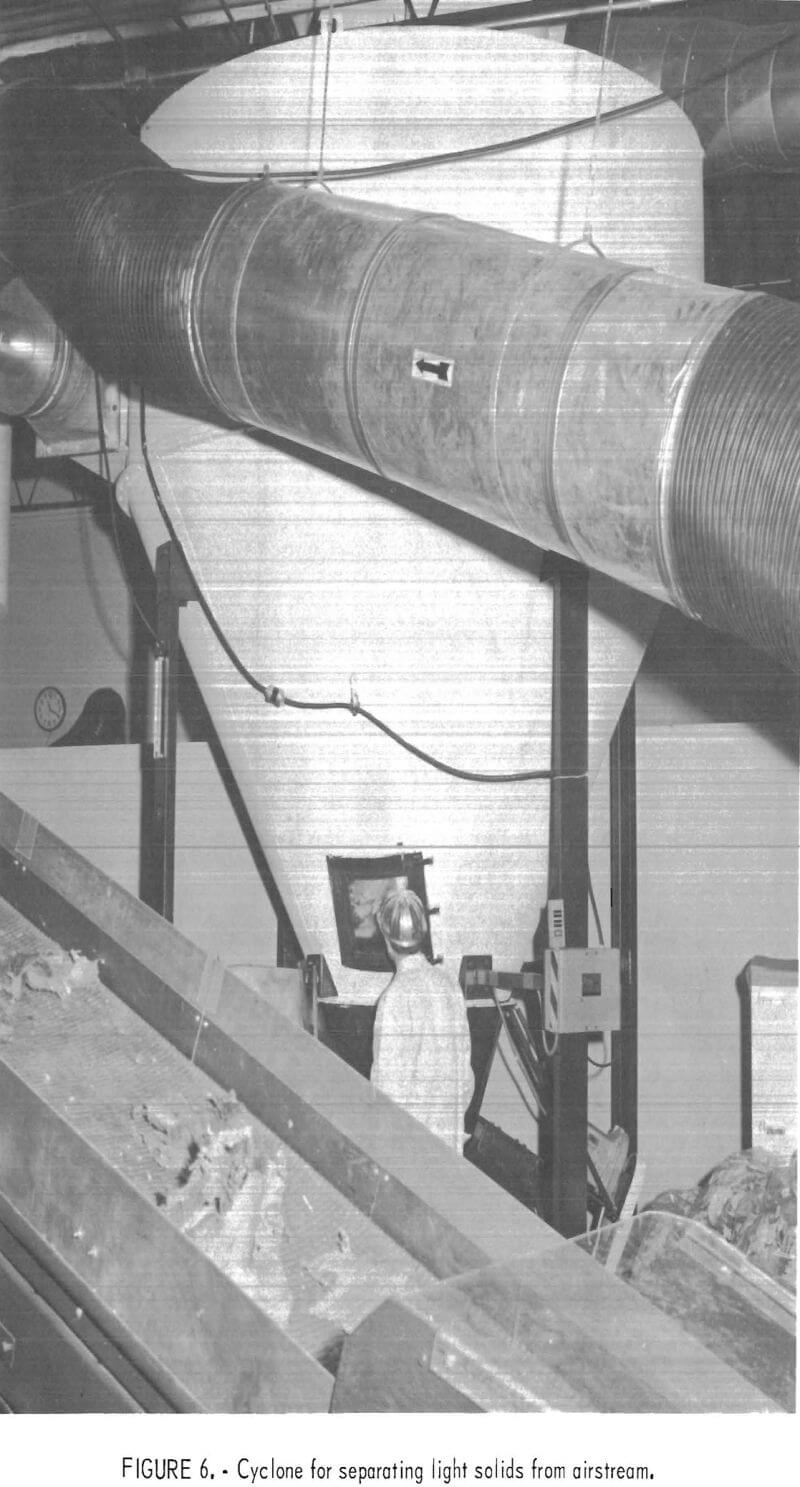

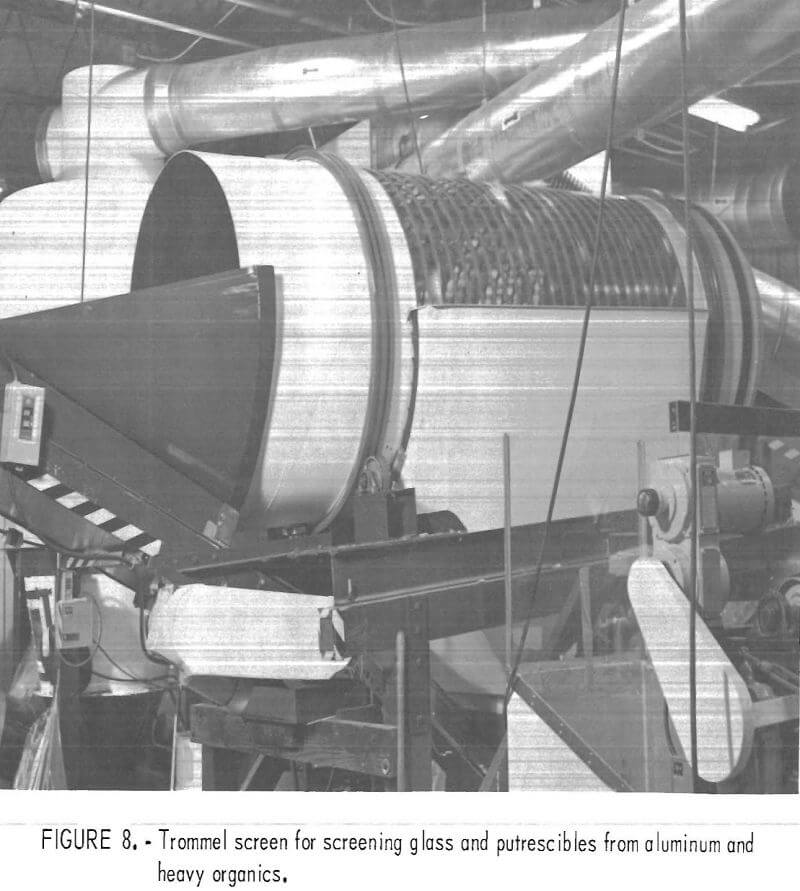
Pilot Plant Performance
Initial testing of the pilot plant has been completed, and preliminary-performance data are now being gathered. Table 1 presents materials balances for some early tests on refuse collected along typical routes in Marlow Heights, Md.


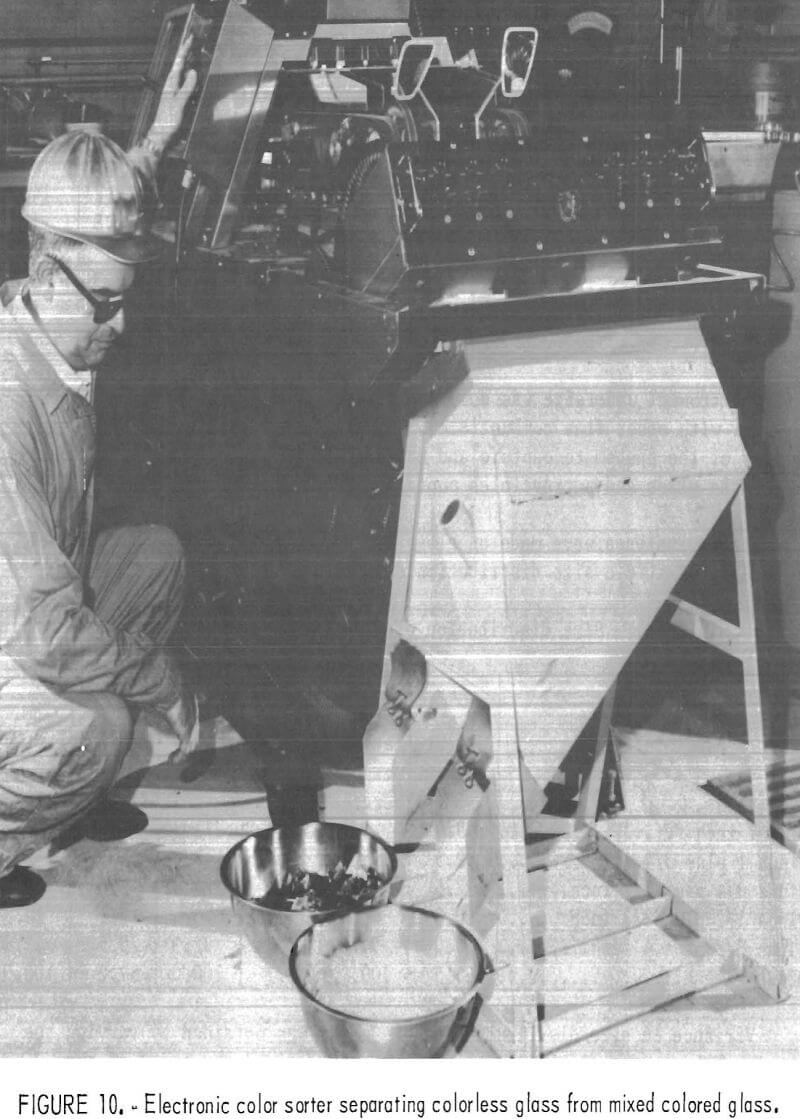
In each of these tests the refuse appeared to be somewhat drier than that normally observed in the storage pits at incinerators. Sample 2 contained 12.8 percent moisture and sample 3 contained 9.7 percent moisture. Drying temperature was 110° C.
The cans contained in the ferrous fraction were only slightly damaged. The various types of cans were easily recognizable so that it was possible to determine the distribution of materials contained in that fraction. The data are presented in table 2.

The trommel undersize was composed primarily of glass and food wastes together with other fine combustibles. Of greatest significance here is the ability of the system to capture and concentrate at a single point essentially all of the glass and putrescibles contained in the incoming refuse.
Screen analyses were made on glass products separated from the trommel undersize. Particle size distribution data are given in table 3.

Variance in size distribution of the glass was obtained by varying the spacing between the flails in the primary shredder and the speed of the rotors. Other conditions at the primary shredder that will affect particle size distribution are rate of feed, the number of flails on each rotor, and the difference in the speed of each rotor. Careful control of these variables can yield a minus 4 mesh glass fraction which is only a few percent of the total. Optimum operation of the entire plant may not allow such a small percentage of glass fines, however.
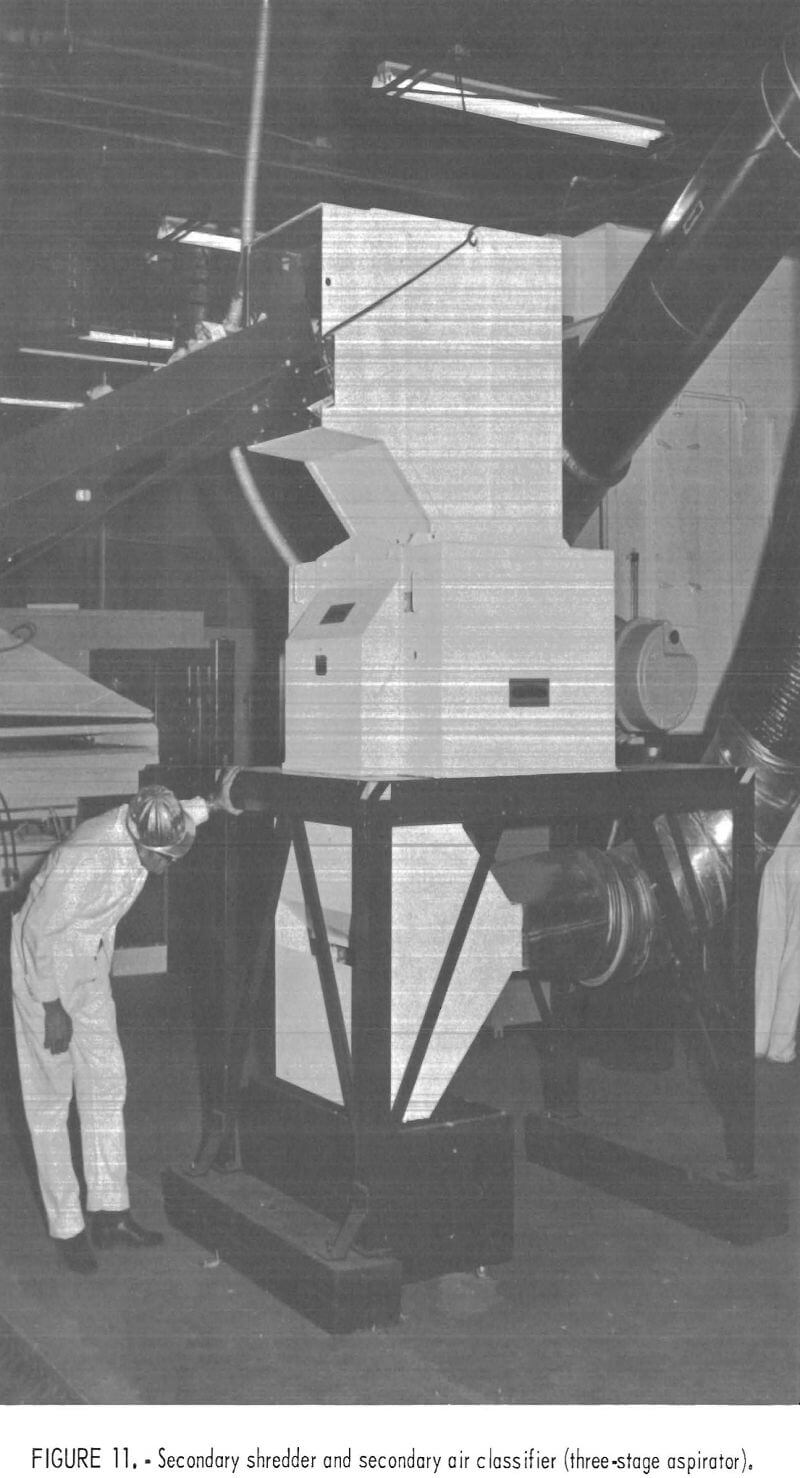

The heavy product from the secondary air classifier (three-stage aspirator) is a much smaller percentage of the incoming refuse than was originally expected. This could be due to the refuse being obtained from a biased sampling area, which was almost entirely residential. Distribution of materials in those products is given in table 4.
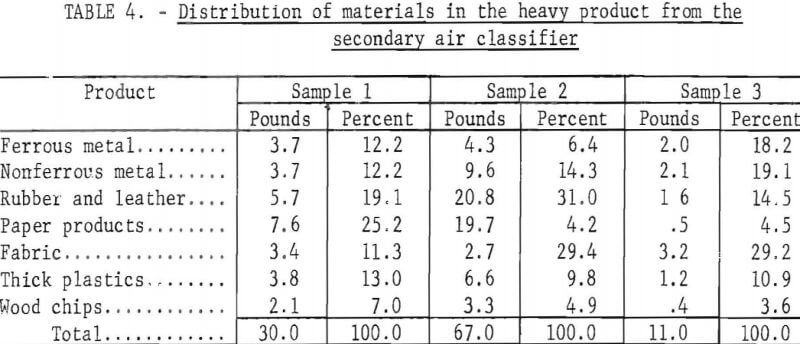
The products listed in table 4 would be expected to contain aluminum from aluminum cans in the refuse. No significant amount of aluminum was found that could have originated from aluminum cans. The all-aluminum can apparently has not infiltrated the metropolitan Washington, D.C., area as it has other cities. A similar product separated from refuse generated in Los Angeles or Miami could be expected to be pre-dominantly aluminum.
No information was obtained on distribution of materials in the cyclone products. However, visual examination of these products showed them to be a relatively clean mixture of paper, plastics, and fabrics. Products from cyclones H and I are noticeably cleaner than the product collected in cyclone J which is more soiled by food wastes and more contaminated by fabric, plastic, and wood splinters. For this reason, the products from cyclones H and I are not being fed to the secondary shredder as indicated in figure 1. Evaluations of these products are being requested from experts in the paper products industries. If the degree of soiling of the product collected in cyclone J does not significantly lower the quality of the total mix, all three products will be joined as indicated in figure 1.
A composite sample of all three cyclone products from sample 2 was prepared and sent to the Bureau’s Energy Research Center in Pittsburgh, Pa., for a determination of its energy value, with the following results:

Results of these early tests are considered highly encouraging. At present, it is anticipated that the greatest single problem will be in the area of materials handling rather than in optimizing the performance of the various pieces of separation equipment.
Figure 13 shows the final products, after upgrading and cleaning, ready for reuse or conversion.
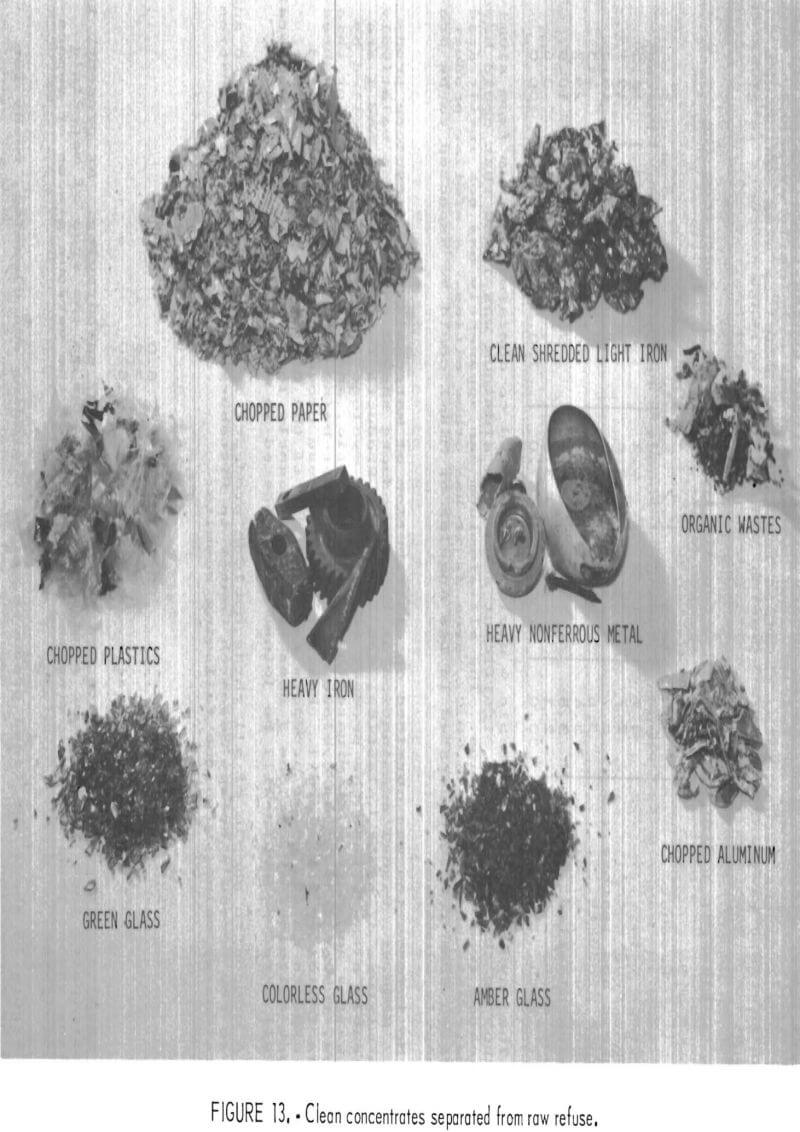
Product Utilization
In the earliest days of its Solid Waste Recycling Research Program, the Bureau of Mines became concerned regarding the potential for marketing reclaimed materials. A grant was awarded to the American Public Works Association (APWA) to conduct case studies of the market potential in six major cities. The studies were limited to products reclaimed from municipal incinerator residues. Many of the product categories now being reclaimed from raw refuse are similar to those obtained from incinerator residues, and in some cases they are of much higher quality.
In their Summary of Observations and Conclusions, the APWA found a “strong market” for the nonferrous metals in each city studied. Market outlets for these products would be dealers and secondary smelters.
The APWA also found that in each case-study city that “the demand for cullet exceeds the available supply” for manufacture of new glass containers. However, the total amount of waste glass that could potentially be made available would probably be far beyond the capacity of the industry to consume it. For this reason, the Bureau of Mines conducted research to develop new, potentially high-volume uses for waste glass. This work resulted in development of some extremely attractive new uses that do not require a raw material glass product of the purity required for cullet. Processes were developed to produce high-quality facing brick, glass wool insulation, reflecting spheres, and floor tile. Cost evaluations for commercial production of these products show favorable economics in every case. Figure 14 illustrates the type of glass brick produced, and figure 15 shows laboratory production of glass wool. Many other new uses for glass are under development, including products such as glasphalt, glass-polymer composite sewer pipe, masonry block, cold-bonded brick, glass-plastic extrusions, slurry seal, building panels, terrazzo flooring, and foamed glass.
The APWA findings were not so encouraging for marketing of incinerated cans. Since incinerated tin cans cannot be detinned economically, the market for this material is very limited. However, in extensive studies conducted

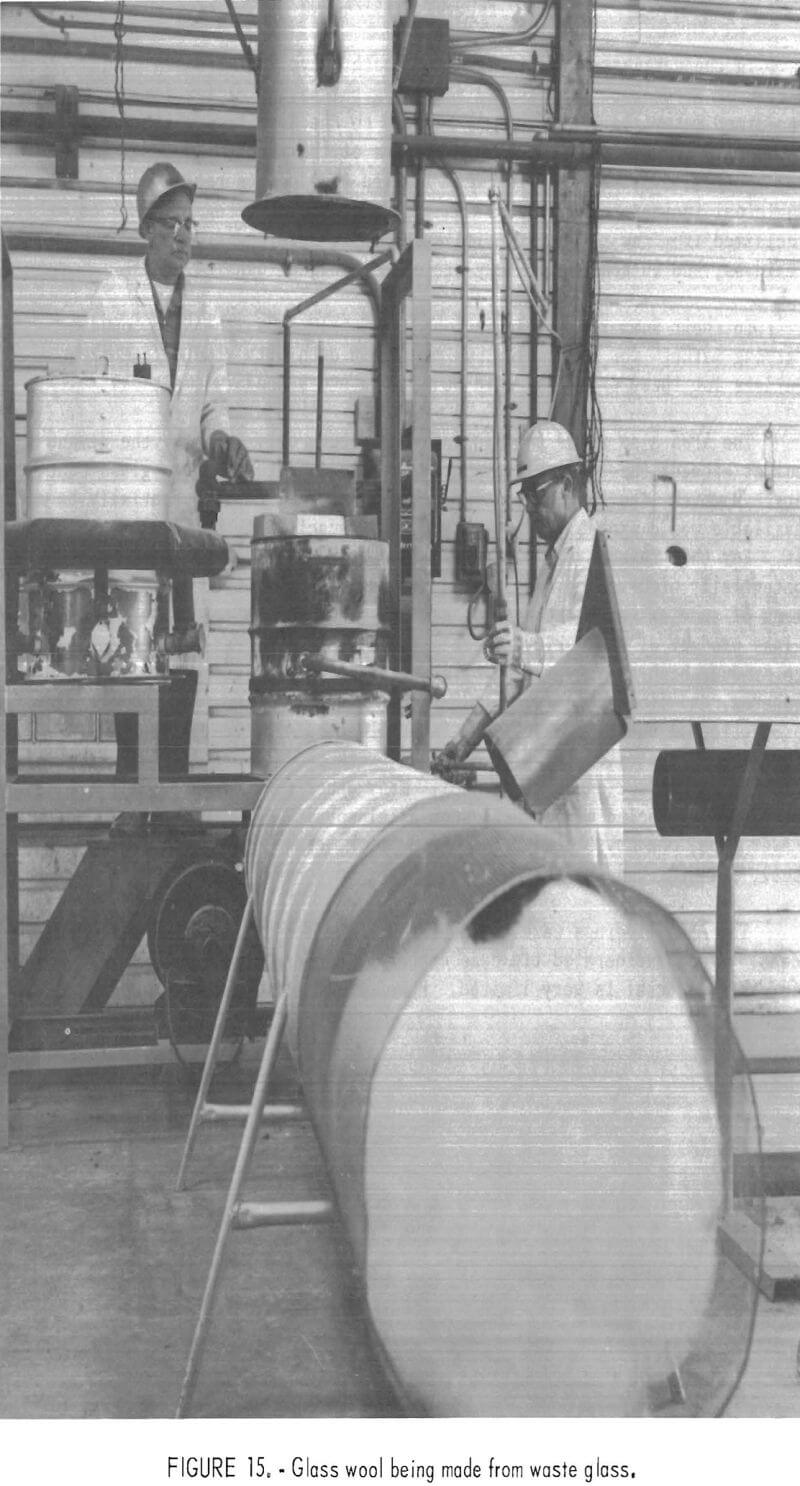
by National Steel Co., it was concluded that incinerator residue scrap can be used in steelmaking and that the amount consumed would be dictated by the levels of residuals, such as copper, tin, and nickel.
The ferrous product reclaimed from raw refuse, unlike that from incinerator residue, will meet specifications for the highest quality scrap since it will have been detinned and baled. This product will be highly desirable for steelmaking. Detinners have traditionally gotten premium prices for similar baled scrap. Bureau laboratory tests have shown that caustic leaching of the shredded, cleaned cans recovered from the pilot plant reduced the tin content to less than 0.03 percent. Two 400-pound samples of the shredded tin cans have been shipped to commercial detinners for evaluation and verification of these results. In addition to these promising prospects, the Bureau of Mines at its Albany (Oreg.) Metallurgy Research Center is conducting research to determine the feasibility of making steel entirely from tinned can scrap, detinned can scrap, and incinerated can scrap as well as mixtures of these products with other grades of scrap and pig iron.
The plastic and paper products from the raw refuse recovery process may find use within their parent industries. In particular, the paper should be suitable for reuse in making new paper, chip board, fiber board, or other cellulose fiber products. Waste plastics to be reused in making new plastic products will probably have to be separated into individual types of plastic. The Bureau of Mines Rolla (Mo.) Metallurgy Research Center has developed a system that can successfully make these separations (12). A pilot model of the equipment used is shown in figure 16.
Process Economics
Preliminary economic evaluations for the process were made, based on the present pilot plant operation as shown in figure 1. Two situations were examined: (1) A 500-ton-per-day plant operating 8 hours per day, 6 days per week, and (2) the same size plant operating 16 hours per day, 6 days per week treating 1,000 tons of refuse daily.
The estimated capital costs for the two plants are

The only differences in the 1,000-tpd plant design are an increase in the storage capacity for raw refuse before processing and addition of a second front-end loader for handling the material.
The estimated operating costs are based on a 312-day operating year. Included in the direct operating costs are raw materials, utilities, labor, maintenance, payroll overhead, and operating supplies. Indirect operating costs include plant overhead, control laboratories, safety, and plant protection. Fixed costs include insurance and depreciation. No local taxes are
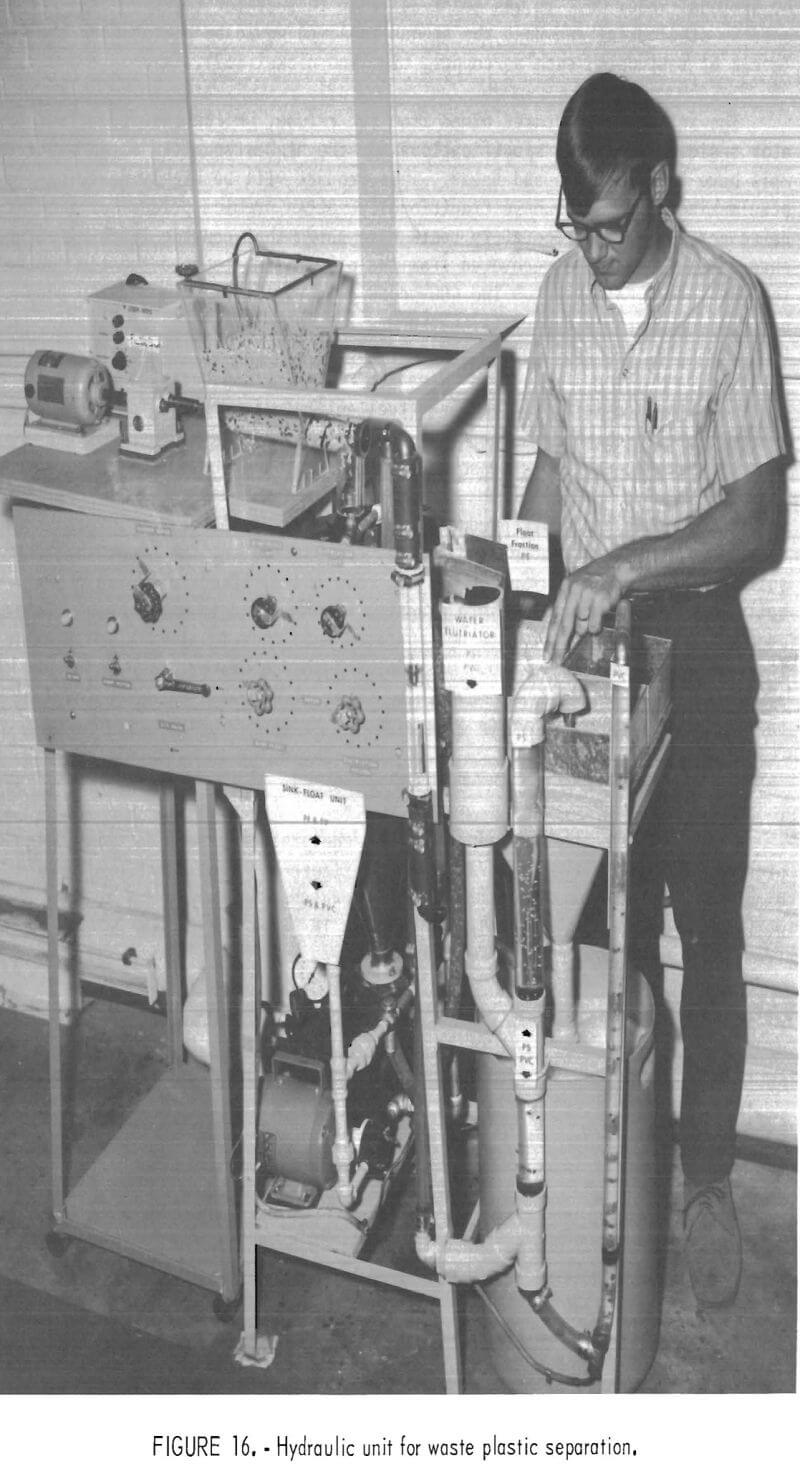
included in the fixed costs because it is assumed the plants will be operated by a city or State Government. Financing expenses have not been included.
The estimated operating cost of the 500-tpd plant is $3.91 per ton of raw refuse fed to the plant. Operating costs for the 1,000-tpd plant are estimated to be $2-69 per ton of refuse processed. These costs represent the costs of separating the raw refuse into the various concentrates shown in figure 13.
Conservative estimates for the probable values of the products are given in table 5. In this table the value assigned to paper and plastics is the lowest probable value (that is, for use as fuel). Estimated values for metals and glass are the same as those assumed for products reclaimed from incinerator residues.
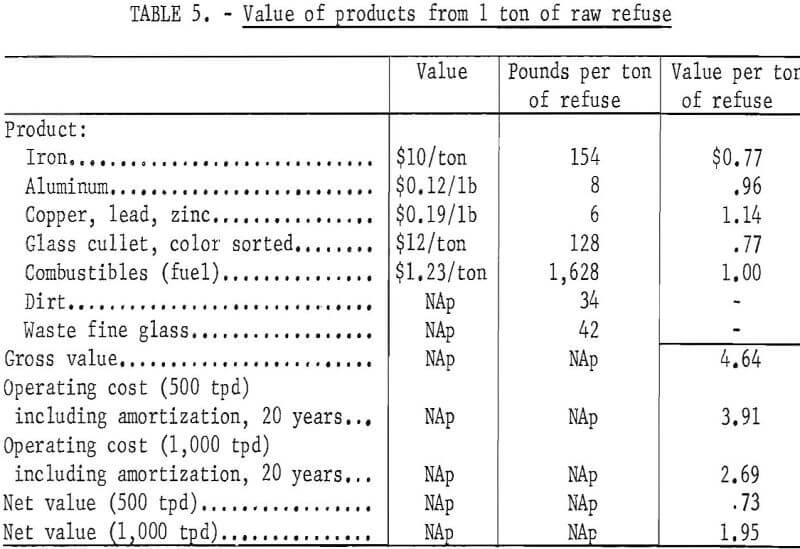
The pounds of products listed in the table are estimates of the most probable amounts that will be found in typical municipal refuse. Published data on refuse composition and Bureau of Mines experience with incinerator residues were used as guides to develop these estimates.
Data in table 3 and experience to date suggest that it should be possible to recover about 75 percent of the glass in a product of particle size larger than 4 mesh, the minimum size feed recommended for color sorting. Only this portion of the glass is assigned a value. Although no value is assigned to the minus 4-mesh glass fraction, this material could conceivably be used in low-value products such as building materials.
One of the most controversial points in discussion of the value of urban wastes is the assignment of a value to combustibles for use as fuel. The value given in table 5 was arrived at on the basis of the following considerations and assumptions. The average heating value of strip mine coal delivered to electric utility plants during the third quarter of 1972 was 10,976 Btu/lb, and the cost f.o.b. the utility was $0.35 per million Btu. Coal from underground mines delivered during the same period had a heating value of 11,846 Btu/lb, and cost $0.40 per million Btu. The cyclone products from the present process have a heating value of about 7,800 Btu/lb. If these products are to be used as a fuel, the other combustible residues from cleaning of glass and metal concentrates would be blended together with them, lowering the heating value of the mixture to an estimated 6,000 Btu/lb. At the low value of $0.35 per million Btu, the energy value of this product would be $4.20 per ton of combustibles, or $3.42 per ton of refuse treated.
For use of combustibles as fuel to be economical, large tonnages would probably be required by the utility. In a major metropolitan area this could be supplied by several refuse processing plants strategically located from the standpoint of collectors. Thus, the combustibles would need to be hauled to the utility. Milled refuse is being delivered to the Union Electric Co. in St. Louis, Mo., in 25-ton loads. Round-trip distance is 16 miles, requiring 2 hours for loading., hauling, unloading, and return. Estimated cost is $1.00 to $1,50 per ton.
In Flint, Mich., estimates for hauling refuse were calculated using the following cost data: $0.15 per mile per truck, plus $0.20 per minute. The haul in St. Louis using these figures is calculated to be $26.40, or $1.06 per ton for 25-ton loads. Using the higher estimate of $1.50 per ton for haulage., the cost for transporting the shredded combustibles from a ton of refuse would be $1.22. The value of combustibles delivered to the utility is then $3.42 minus $1.22, or $2.20 per ton of refuse treated. Yet to be deducted would be cost for recovery of capital invested to modify boilers, minor increases in operating costs, and some added economic incentive to the utility to persuade them to use refuse as a significant portion of their energy input. A generous allotment to cover those costs would be $1.20 per ton of refuse treated, leaving a net value of $1.00 for the combustibles in a ton of refuse.
The most significant cost benefit to be realized by resource recovery will be savings in cost of hauling to remote landfills and in cost of landfill operations. A conservative estimate for savings by delivering refuse to a processing plant rather than a landfill is $1 per ton. Nationwide, the average cost of sanitary landfill is quoted as being $2 to $4 per ton without ground water protection. Estimated cost for landfill operation by Baltimore, Md., is 45 cents per cubic yard. Assuming a density of 400 lb/yd³, Baltimore’s cost is $2.25 per ton. The Brown Station Road landfill in Prince Georges County, Md., has operating costs of $2.75 per ton, including amortization of land purchases. Taking into account that 76 pounds of waste dirt and fine glass from the present process must be disposed per ton of refuse treated, a conservative estimate of $2 per ton is made for additional savings to be realized through resource recovery. Total savings and revenues for both 500-tpd and 1,000-tpd modes of plant operation are given in table 6.

Indirect benefits difficult to quantify, but of major significance, are the potential contribution of the process to conservation of valuable material resources, savings in energy requirements over that needed for production of virgin materials, and preservation of the environment by avoiding pollution of air, water, and land.
Future Plans
Tests described in this report were made primarily to familiarize and train pilot plant operators. Various unit operations have not yet been optimized. One of the immediate tasks is to determine accurately the maximum processing capacities of all equipment in the plant. At the same time, opportunities for improving quality of the product concentrates will be investigated and new product cleaning operations will be installed. A small trommel screen that can be fitted with either ½-inch or ¾-inch punch plate screens is being installed for treating the large trommel undersize to remove most of the paper and other combustibles from glass and putrescibles. Water elutriators will be installed to reclaim glass from the latter fraction and to reclaim nonferrous metal from the heavy product of the secondary air classifier. Jigs, log washers, and air tables are also available to determine their applicability for making these same separations.
It is not likely that any single truckload of refuse delivered to the pilot plant will constitute a typical urban refuse mix. A plan is now being devised for strategic sampling of the metropolitan area to assure, as much as possible, that materials are obtained which represent composition extremes available in the area, Attempts will also be made at random sampling of refuse as it is delivered to landfills and incinerators in an effort to collect as nearly as possible a typical refuse mix. The effects of seasonal variations in refuse composition on pilot plant performance must also be determined. Daily variations might also be encountered; that is, composition of refuse generated on weekends and holidays may differ from that of refuse generated on normal working days. When the plant has been optimized, truck loads of refuse from other cities will also be obtained and processed to observe effects on plant performance of variations in composition due to geographic location and degree of industrial activity.
As engineering data is obtained, it will be passed on to the Bureau of Mines cost evaluation engineers so that cost estimates for commercial-size plants can be constantly refined with increased reliability.
Some pilot plant products are already being supplied to other researchers in both industry and Government. As larger quantities become available, they will be supplied to potential consuming industries for evaluation as raw materials for reuse in new consumer products. Response from these industries will be extremely important in helping to guide the research for optimizing the flowsheet.
